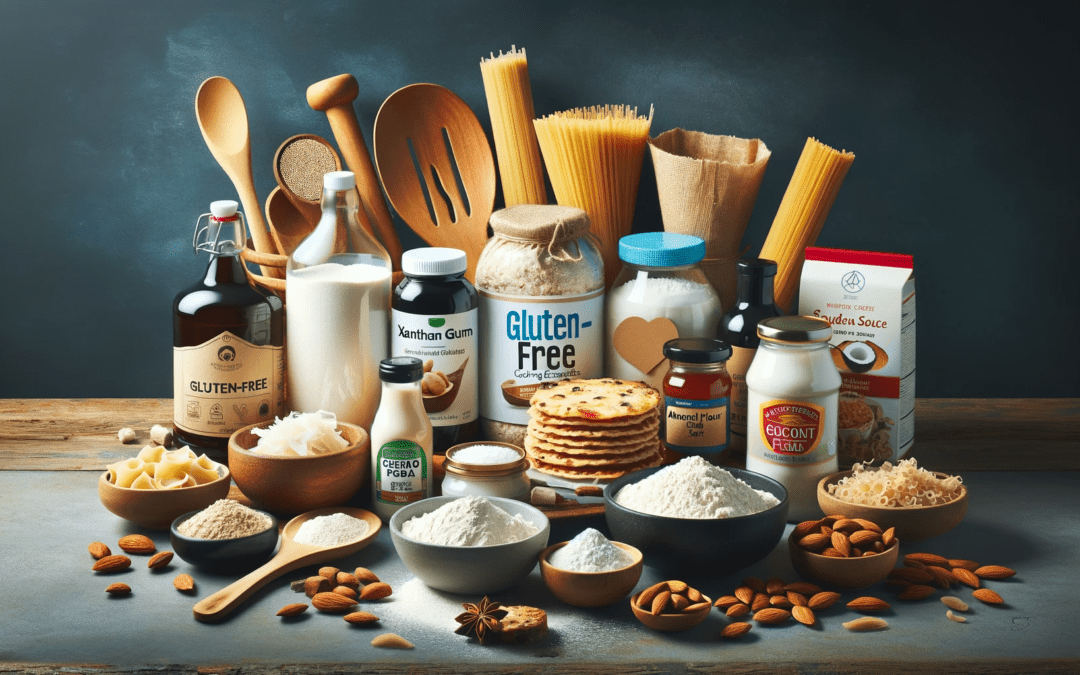Gluten-free cooking is more than a dietary choice; it’s a lifestyle for many. Whether due to celiac disease, gluten sensitivity, or personal preference, having the right gluten-free cooking essentials can transform your kitchen into a haven for delicious, safe, and nutritious meals. This article highlights the top ten must-have products for gluten-free cooking, ranging from staple ingredients to innovative substitutes. These selections are designed to make gluten-free cooking both enjoyable and straightforward, ensuring that you never miss out on flavor or variety.
1. Bob’s Red Mill Gluten-Free 1-to-1 Baking Flour (Amazon)
- Key Features: Blend of gluten-free flours, 1-to-1 substitution for wheat flour.
- Pros: Versatile for baking, excellent texture and taste.
- Cons: May require additional binding agents for some recipes.
- Description: Bob’s Red Mill Gluten-Free 1-to-1 Baking Flour is a staple in any gluten-free kitchen. Designed to replace wheat flour directly, it makes gluten-free baking hassle-free. Its blend of rice flour, potato starch, and other gluten-free flours provide a texture and taste comparable to traditional flour. While some recipes may need extra xanthan gum or binding agents, this flour is a game-changer for gluten-free bakers.
2. Xanthan Gum by Anthony’s (Amazon)
- Key Features: Natural thickener and stabilizer, essential for gluten-free baking.
- Pros: Improves texture in gluten-free baked goods, small amounts needed.
- Cons: Can be tricky to use correctly, may cause digestive discomfort for some.
- Description: Xanthan Gum by Anthony’s is a critical ingredient for gluten-free baking. It acts as a stabilizer and thickener, replacing the binding properties of gluten. It helps in creating the right texture in bread, cakes, and cookies. Only a small amount is needed, making it a long-lasting addition to your pantry. Proper usage is key as it can become gummy if overused, and some individuals may find it causes digestive issues.
3. King Arthur Gluten-Free Measure for Measure Flour (Amazon)
- Key Features: Wheat flour substitute, fortified with vitamins and minerals.
- Pros: Easy to use, no need to add extra xanthan gum.
- Cons: Slightly different taste from regular flour, may be more expensive.
- Description: King Arthur Gluten-Free Measure for Measure Flour is another excellent wheat flour alternative. It’s particularly user-friendly, as it requires no additional xanthan gum or complicated recipe adjustments. This flour is also fortified, adding nutritional value to your gluten-free baked goods. The taste may differ slightly from traditional flour, and the price point is a bit higher, but its convenience and quality are well worth it.
4. Nutiva Organic Coconut Flour (Amazon)
- Key Features: High fiber, low-carb, versatile for baking and cooking.
- Pros: Nutrient-rich, adds a unique flavor, good for various diets.
- Cons: Requires more liquid in recipes, may have a distinct coconut flavor.
- Description: Nutiva Organic Coconut Flour is a fantastic gluten-free flour alternative, especially for those following low-carb or paleo diets. It’s high in fiber and protein, adding nutritional benefits to your dishes. While it imparts a mild coconut flavor and requires adjustments in the amount of liquid in recipes, its versatility in both sweet and savory dishes makes it a valuable ingredient.
5. Barilla Gluten-Free Pasta (Amazon)
- Key Features: Corn and rice flour blend, classic pasta taste and texture.
- Pros: Cooks like traditional pasta, widely available, suitable for various dishes.
- Cons: Can become mushy if overcooked, slightly different texture from wheat pasta.
- Description: Barilla Gluten-Free Pasta offers the experience of traditional pasta without the gluten. Made from a blend of corn and rice flour, it maintains a taste and texture similar to regular pasta. It’s versatile for a variety of dishes, from spaghetti to macaroni. Attention is needed while cooking, as it can turn mushy if overcooked. The texture may slightly differ from wheat pasta, but it’s a delicious and accessible option for gluten-free diets.
6. San-J Tamari Gluten-Free Soy Sauce (Amazon)
- Key Features: Soy sauce alternative, no wheat, rich umami flavor.
- Pros: Authentic soy sauce taste, versatile in cooking, available in low-sodium versions.
- Cons: Slightly more expensive than regular soy sauce, contains soy (allergen for some).
- Description: San-J Tamari Gluten-Free Soy Sauce is an excellent alternative for those missing the rich flavor of traditional soy sauce. Made without wheat, it provides the umami depth essential in many Asian and fusion dishes. It’s available in low-sodium versions, catering to various dietary needs. While more expensive than regular soy sauce and containing soy (a potential allergen), its authentic taste makes it a must-have for gluten-free cooking.
7. Almond Flour by Blue Diamond (Amazon)
- Key Features: Fine ground almonds, low in carbs, high in nutrients.
- Pros: Adds a rich, nutty flavor, good for baking and breading.
- Cons: Higher in calories and fat, different texture from wheat flour.
- Description: Blue Diamond’s Almond Flour is a popular gluten-free flour choice, offering a rich, nutty flavor. Its low-carb and high-nutrient profile make it suitable for various health-conscious diets. Almond flour is versatile, useful for baking and as a breading alternative. It’s higher in calories and fat compared to traditional flour and has a different texture, but its flavor and nutritional value are a significant draw for many.
8. Gluten-Free Oats by Bob’s Red Mill (Amazon)
- Key Features: Certified gluten-free, whole grain oats.
- Pros: Versatile for breakfast and baking, high in fiber.
- Cons: More expensive than regular oats, may have a different texture.
- Description: Bob’s Red Mill Gluten-Free Oats are a safe and nutritious choice for those on a gluten-free diet. These whole grain oats are versatile, perfect for breakfast porridge or as an ingredient in baking. They provide a good source of fiber and are naturally gluten-free, though they are processed in a facility that ensures no cross-contamination. While slightly more expensive and possibly having a different texture than regular oats, they offer the warmth and comfort of traditional oats without the gluten.
9. Schar Gluten-Free Artisan Baker Multigrain Bread (Amazon)
- Key Features: Wheat-free, multigrain bread, high in fiber.
- Pros: Close to traditional bread taste and texture, long shelf life.
- Cons: Can be dry, more expensive than regular bread.
- Description: Schar Gluten-Free Artisan Baker Multigrain Bread is a fantastic alternative for those missing traditional bread. It offers a texture and taste close to wheat-based bread, enriched with various grains and fibers. The bread has a long shelf life, which is convenient, though it can be drier than regular bread. While more expensive, it’s a great option for sandwiches or toast, making it a staple in any gluten-free kitchen.
10. Gluten-Free Baking Powder by Rumford (Amazon)
- Key Features: Aluminum-free, non-GMO, double-acting.
- Pros: Effective in gluten-free baking, no aftertaste.
- Cons: Requires proper storage, can lose potency over time.
- Description: Rumford’s Gluten-Free Baking Powder is an essential ingredient for gluten-free baking, ensuring that cakes and bread rise properly. It’s aluminum-free and non-GMO, guaranteeing no metallic aftertaste. While effective, it requires proper storage to maintain its potency and can lose effectiveness over time. This baking powder is a reliable choice for achieving the desired texture in gluten-free baked goods.
Embracing a gluten-free diet doesn’t mean sacrificing taste or variety in your cooking. These top ten gluten-free cooking essentials provide the foundation for a diverse and delicious culinary experience. From flours and pastas to sauces and bread, these products ensure that you can enjoy a wide range of dishes while adhering to your dietary needs. Whether you’re a seasoned gluten-free cook or just starting out, these essentials will help you master the art of gluten-free cuisine.
FAQ’s
1. What are the most important gluten-free cooking essentials to have in your kitchen?
When it comes to gluten-free cooking, having the right essentials in your kitchen can make a significant difference. The most important gluten-free cooking essentials include a variety of gluten-free flours like almond, coconut, and rice flour, which serve as the base for many recipes. Xanthan gum is a key ingredient that acts as a binder in gluten-free baking. Other essentials include gluten-free pasta, bread, and oats, which are staples in many diets but often contain gluten. Tamari sauce, a gluten-free alternative to soy sauce, and gluten-free baking powder are also crucial for adding flavor and leavening to dishes. Additionally, having a stock of gluten-free snacks and condiments, such as crackers, nut butters, and salad dressings, can help in maintaining a gluten-free diet without sacrificing flavor or convenience.
2. How can you substitute traditional ingredients with gluten-free options without compromising taste and texture?
Substituting traditional ingredients with gluten-free options can be challenging, but with the right techniques, it’s possible to create dishes that are just as tasty and have a satisfying texture. One key approach is to use a blend of gluten-free flours instead of just one type to mimic the properties of wheat flour. For example, combining rice flour with tapioca and potato starch can give baked goods a lighter texture. Using xanthan gum or guar gum can help mimic the elasticity and stickiness of gluten. When it comes to savory dishes, ingredients like quinoa, buckwheat, and amaranth are excellent substitutes for traditional grains like barley or couscous. Experimenting with different herbs and spices can also enhance the flavor profile of gluten-free dishes, making them just as delicious as their traditional counterparts.
3. What are some creative ways to incorporate gluten-free grains into everyday meals?
Incorporating gluten-free grains into everyday meals can be both creative and nutritious. Quinoa, a versatile and protein-rich grain, can be used in salads, as a base for stir-fries, or even as a breakfast cereal. Millet is another excellent gluten-free grain that can be used in place of rice or made into a creamy porridge. Buckwheat, despite its name, is gluten-free and works wonderfully in pancakes, noodles (like Japanese soba), and as a rice alternative in risottos. Amaranth, with its nutty flavor, can be popped like popcorn for a snack, added to soups, or used to thicken stews. These grains not only add variety to the diet but also offer unique flavors and textures that can enhance a wide range of dishes.
4. Can you suggest some quick and easy gluten-free meal ideas for busy weeknights?
For busy weeknights, quick and easy gluten-free meal ideas can be a lifesaver. One great option is a stir-fry using gluten-free tamari sauce, mixed vegetables, and a protein source like tofu or chicken, served over quinoa or gluten-free noodles. Another idea is gluten-free pasta with a simple sauce like marinara or pesto, accompanied by a fresh salad. Gluten-free tacos or fajitas using corn tortillas, with fillings like grilled vegetables, beans, and cheese, are both easy to prepare and customizable. Additionally, omelets or frittatas packed with vegetables and cheese are not only quick but also a great way to use up leftovers. For an even simpler option, gluten-free soups or stews can be prepared in advance and reheated, providing a nourishing meal with minimal effort.
5. What are some essential tips for avoiding cross-contamination in a kitchen that isn’t exclusively gluten-free?
Avoiding cross-contamination in a kitchen that isn’t exclusively gluten-free requires careful attention to detail. First, it’s crucial to have separate cooking and preparation utensils for gluten-free foods, including pots, pans, and cutting boards. Color-coding these items can be a helpful reminder. Always thoroughly clean surfaces before preparing gluten-free meals, and consider using disposable paper towels instead of shared sponges or cloths. Store gluten-free products in separate, clearly labeled containers, and if possible, dedicate a specific area of the kitchen to gluten-free preparation. Be mindful of ingredients that may contain hidden gluten, such as condiments and cooking sprays. Lastly, educating family members or housemates about the importance of these measures can help maintain a safe, gluten-free-friendly kitchen environment.











